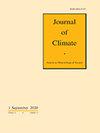Important influence of North Atlantic Oscillation on interannual variability of the boreal autumn East Siberian-Beaufort Sea ice
IF 4.8
2区 地球科学
Q1 METEOROLOGY & ATMOSPHERIC SCIENCES
引用次数: 0
Abstract
Abstract The East Siberia-Beaufort (EsCB) sea ice during boreal autumn has recently been reported to play important roles in the climate over Eurasia and North America. The EsCB sea ice exhibits remarkable year-to-year fluctuations in autumn (August-September-October), the season in which its minimum extent usually occurs. However, the physical driver of the autumn EsCB sea ice interannual variability remains unclear, impeding the seasonal prediction of local sea ice. Here we find that the autumn EsCB sea ice variability is largely driven by the preceding summer (May-June-July) dipolar atmospheric anomalies over the North Atlantic, resembling the North Atlantic Oscillation (NAO) pattern. During the negative NAO-like phase, the circumpolar anticyclonic anomalies tend to transport the warm air from Greenland towards the EsCB region, which triggers rapid sea ice melt there. The associated EsCB sea ice anomalies can be maintained or even intensified by the local sea ice-albedo positive feedback until autumn. Therefore, the abnormal signals of Arctic sea ice tend to show significant persistence in summer and autumn. The influence of the summer NAO-like atmospheric circulation on the ensuing autumn EsCB sea ice can be realistically reproduced in the historical simulation of the E3SM-1-0 model, supporting our findings based on the observation. This lagged relationship provides a promising pathway for skillful seasonal prediction of the EsCB sea ice and its related climatic impacts.北大西洋涛动对北方秋季东西伯利亚-波弗特海冰年际变化的重要影响
东北西伯利亚-波弗特(EsCB)海冰在欧亚大陆和北美地区的气候中起着重要的作用。EsCB海冰在秋季(8 - 9 - 10月)表现出显著的年度波动,通常是海冰最小的季节。然而,秋季EsCB海冰年际变化的物理驱动因素尚不清楚,这阻碍了对当地海冰的季节性预测。在此,我们发现秋季的EsCB海冰变化在很大程度上是由之前夏季(5 - 6 - 7月)北大西洋的偶极大气异常驱动的,类似于北大西洋涛动(NAO)模式。在负的类nao相期间,环极反气旋异常倾向于将格陵兰岛的暖空气输送到EsCB地区,从而引发该地区的海冰快速融化。当地海冰反照率正反馈可以维持甚至加剧相关的EsCB海冰异常,直至秋季。因此,北极海冰异常信号在夏秋两季往往表现出显著的持续性。E3SM-1-0模式的历史模拟能够真实再现夏季类nao大气环流对随后秋季EsCB海冰的影响,支持了我们基于观测的发现。这种滞后关系为熟练地预测EsCB海冰及其相关气候影响提供了一条有希望的途径。
本文章由计算机程序翻译,如有差异,请以英文原文为准。
求助全文
约1分钟内获得全文
求助全文
来源期刊

Journal of Climate
地学-气象与大气科学
CiteScore
9.30
自引率
14.30%
发文量
490
审稿时长
7.5 months
期刊介绍:
The Journal of Climate (JCLI) (ISSN: 0894-8755; eISSN: 1520-0442) publishes research that advances basic understanding of the dynamics and physics of the climate system on large spatial scales, including variability of the atmosphere, oceans, land surface, and cryosphere; past, present, and projected future changes in the climate system; and climate simulation and prediction.
 求助内容:
求助内容: 应助结果提醒方式:
应助结果提醒方式:


